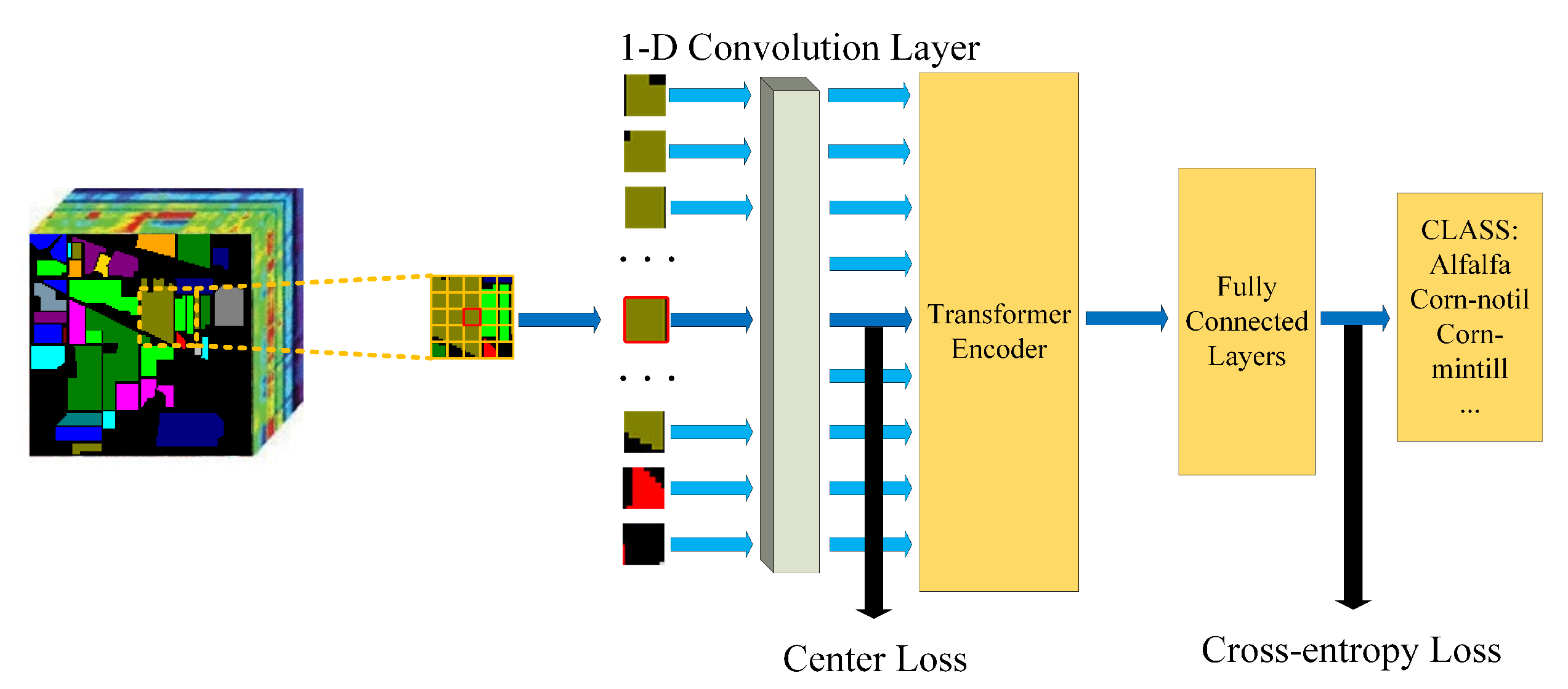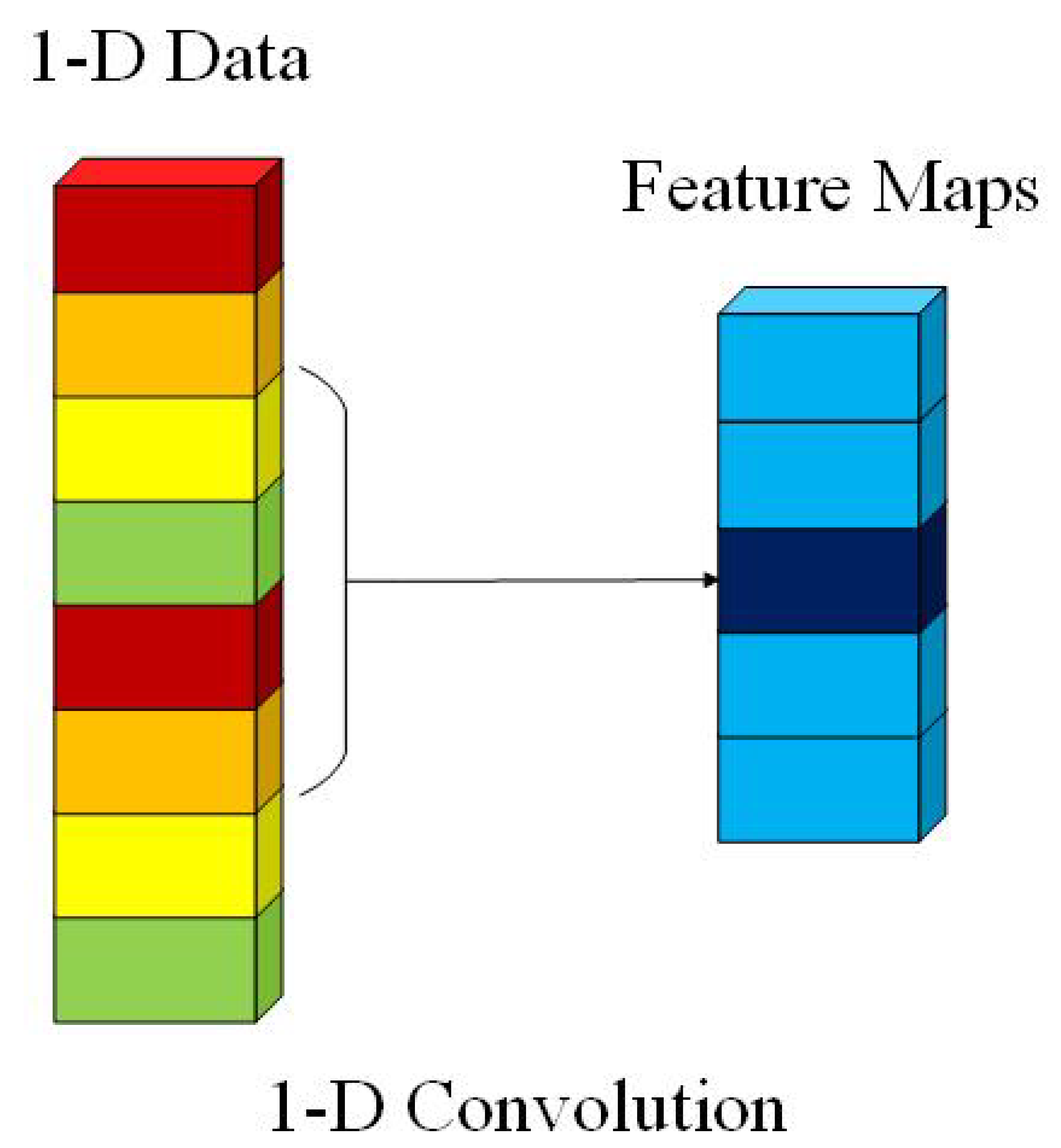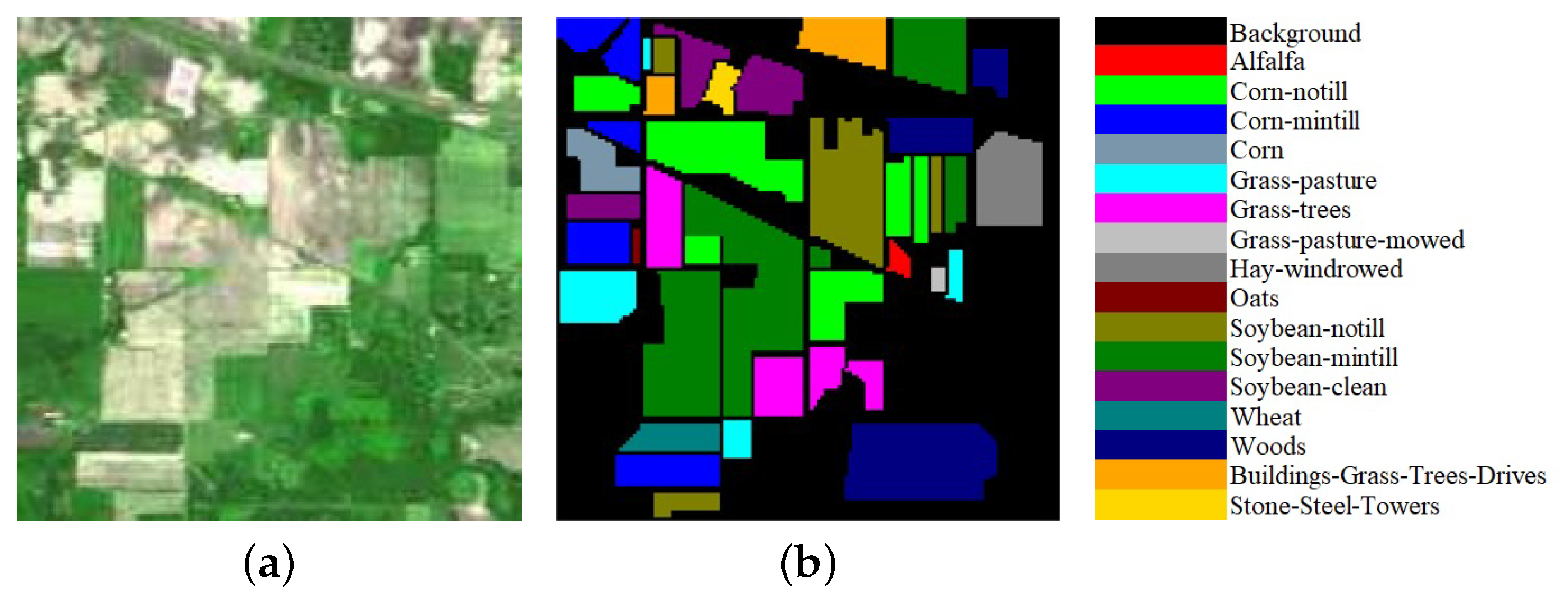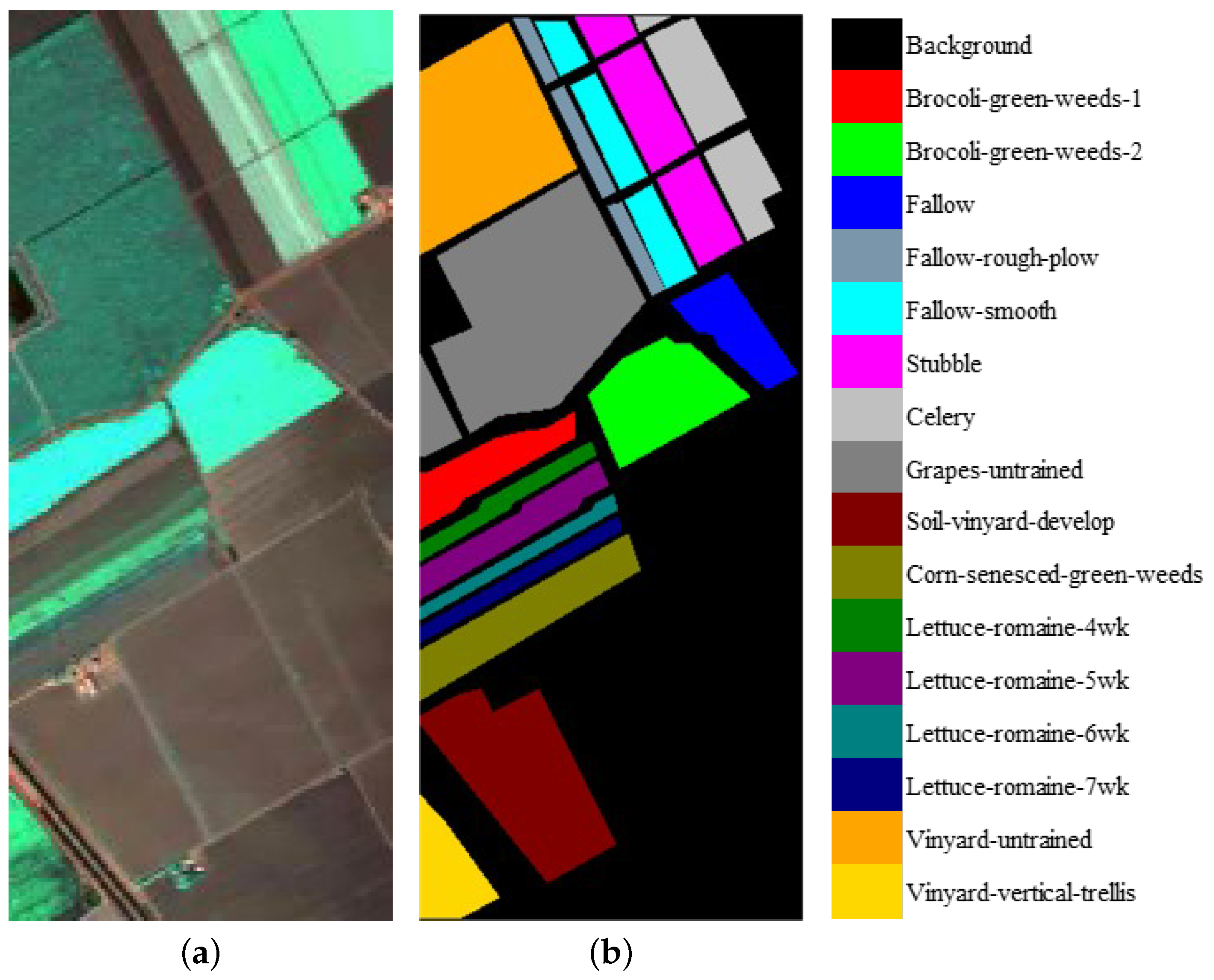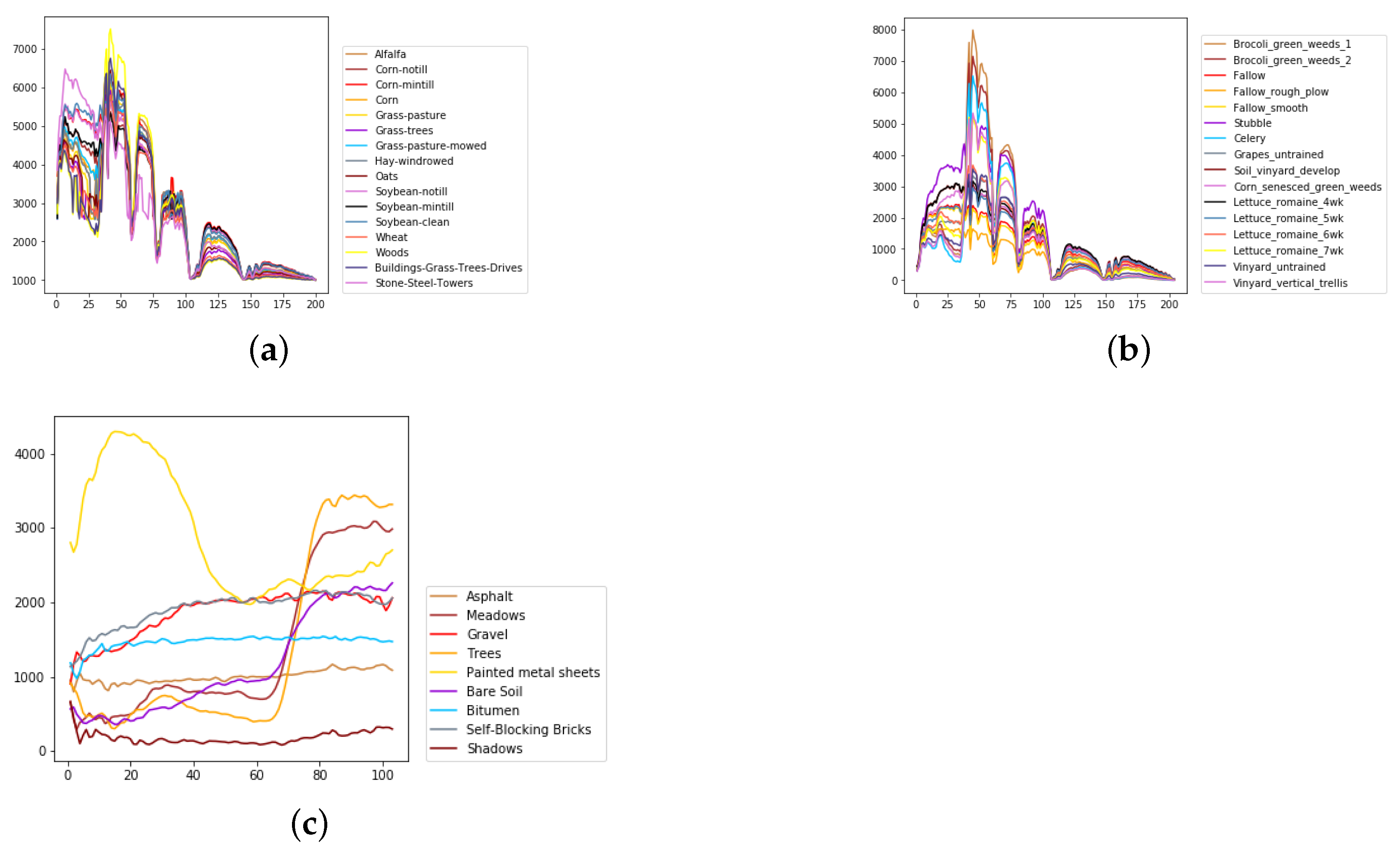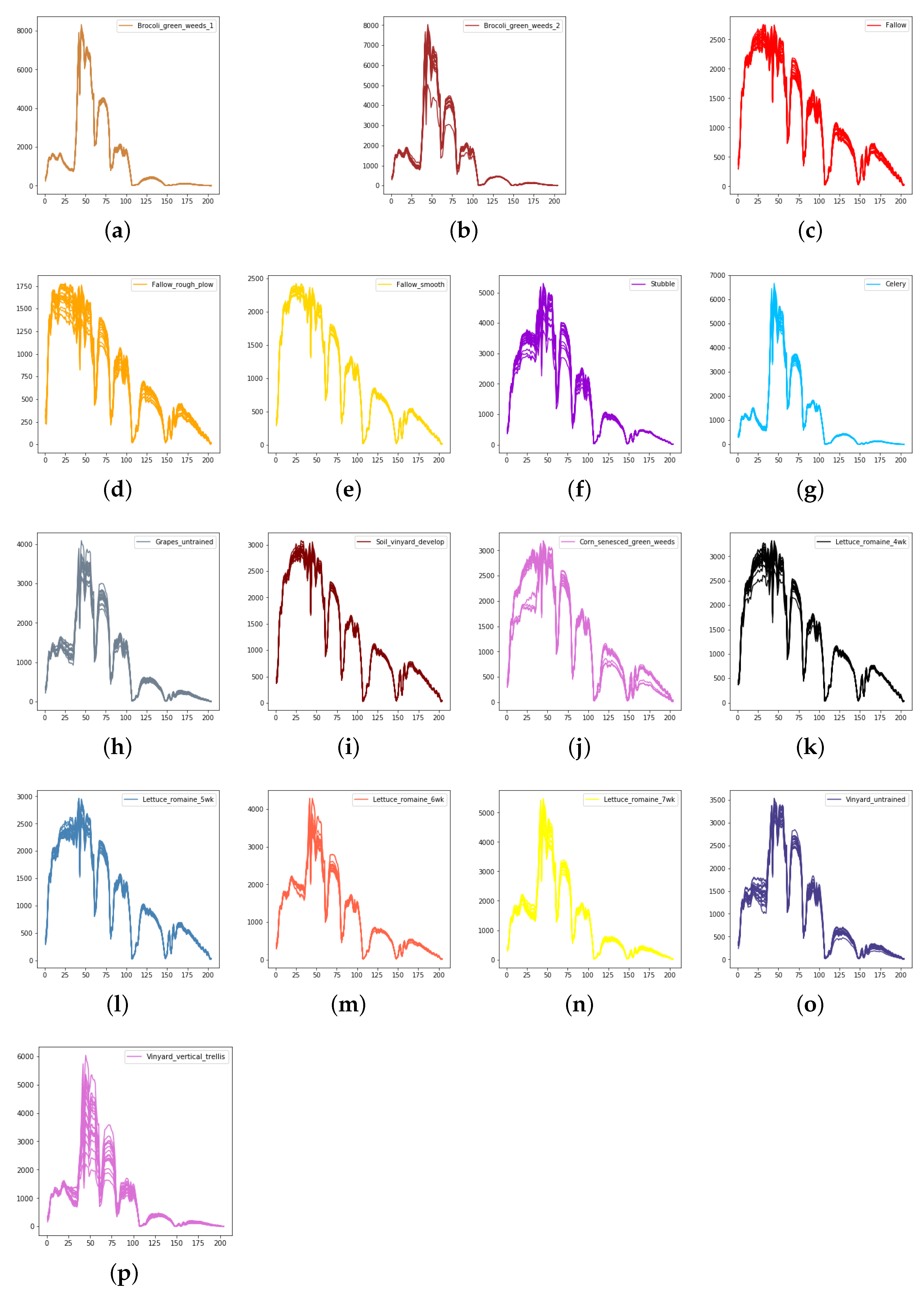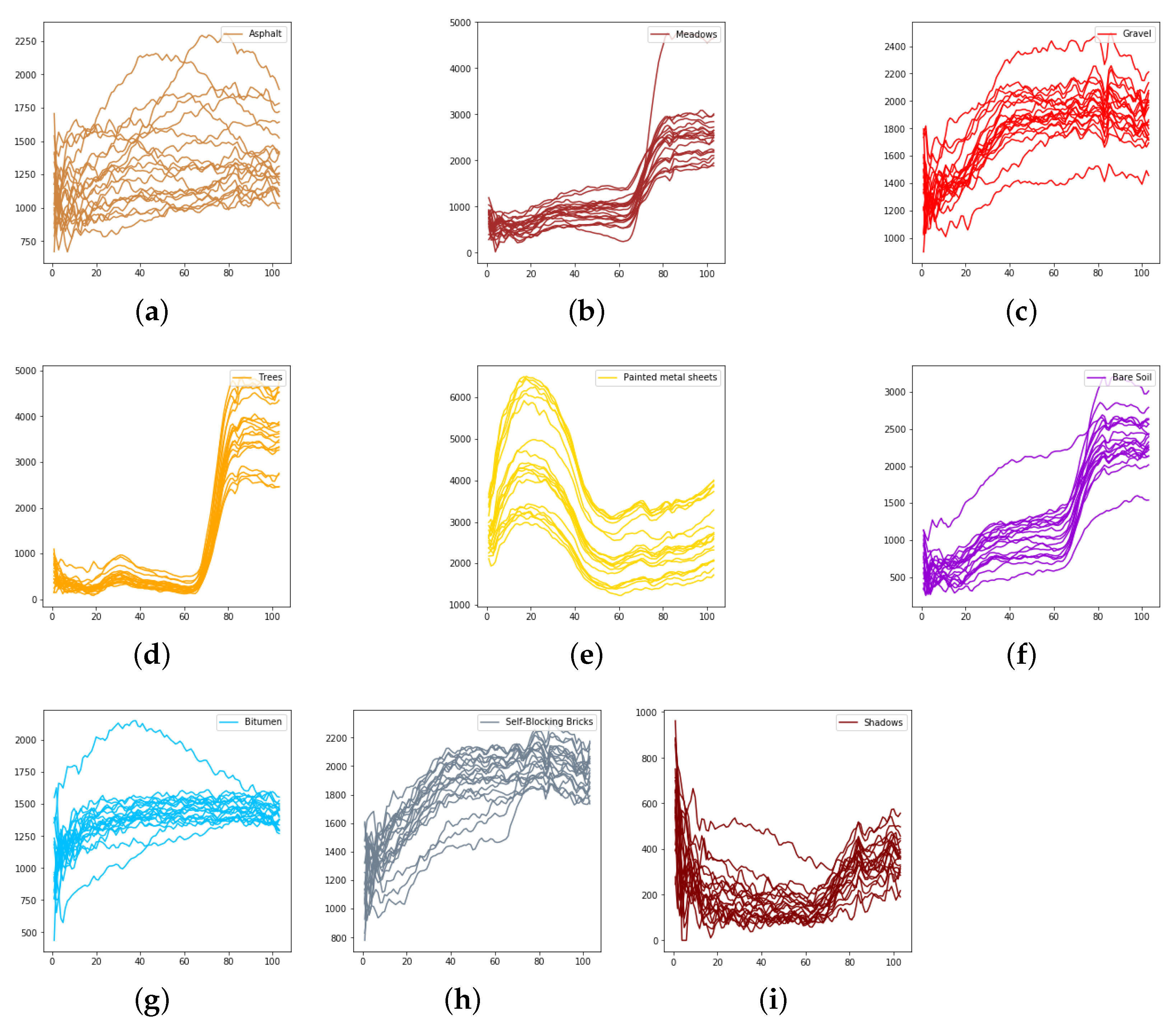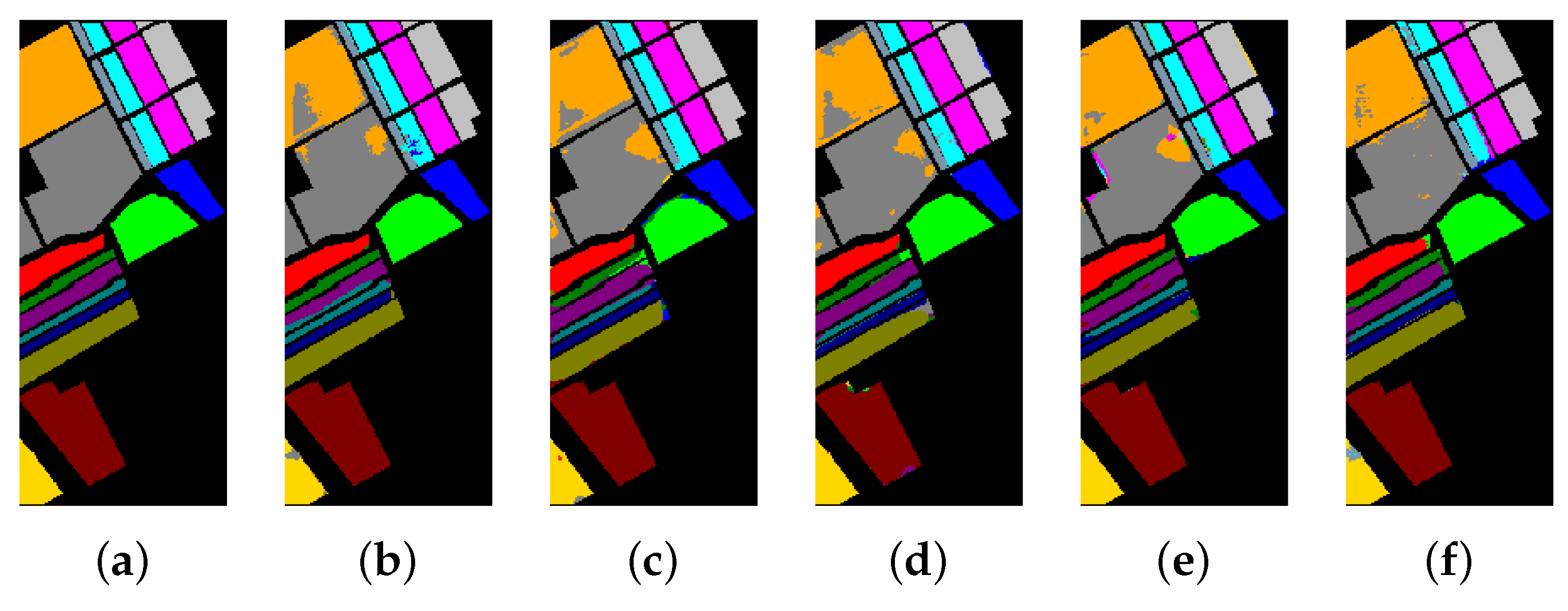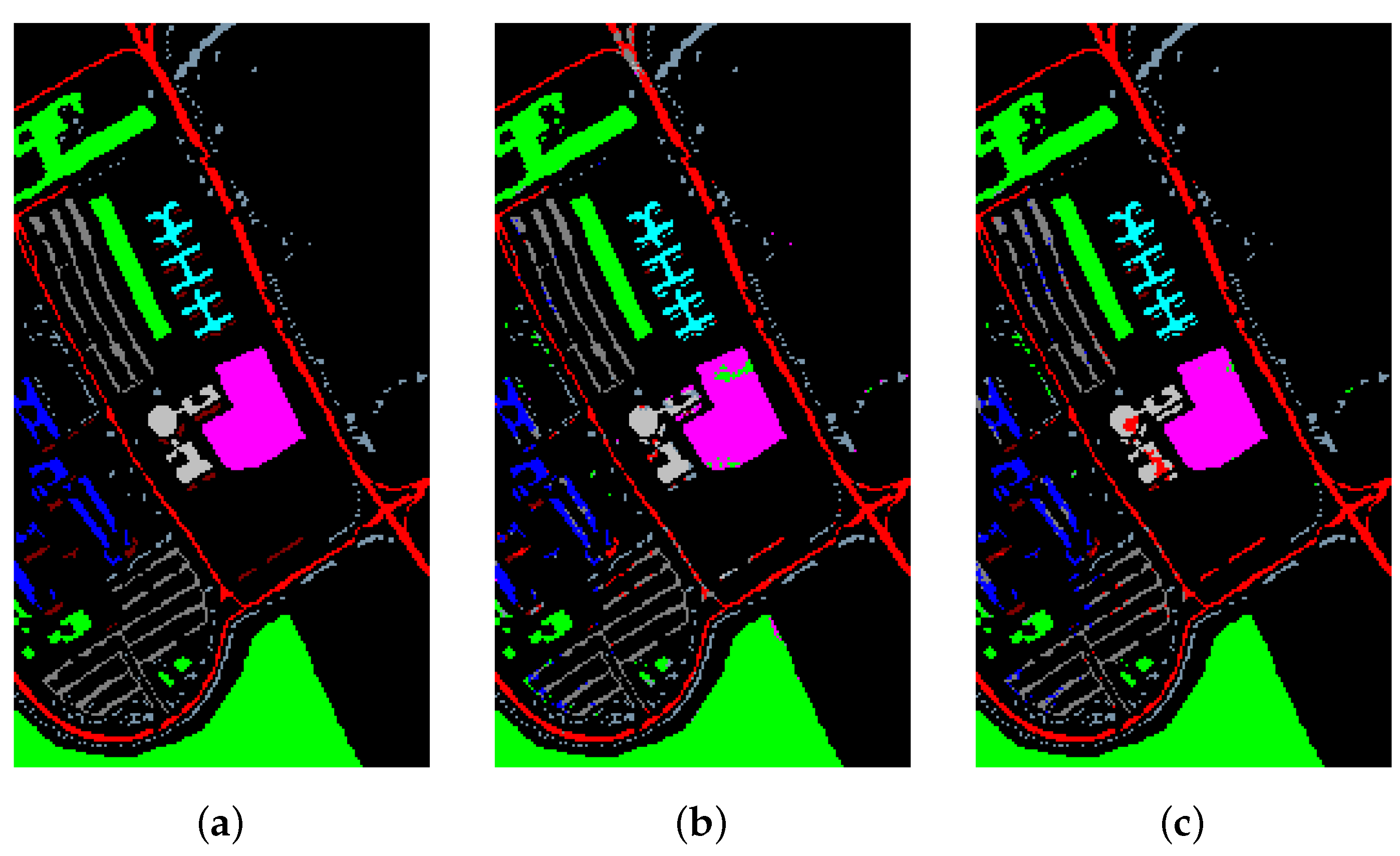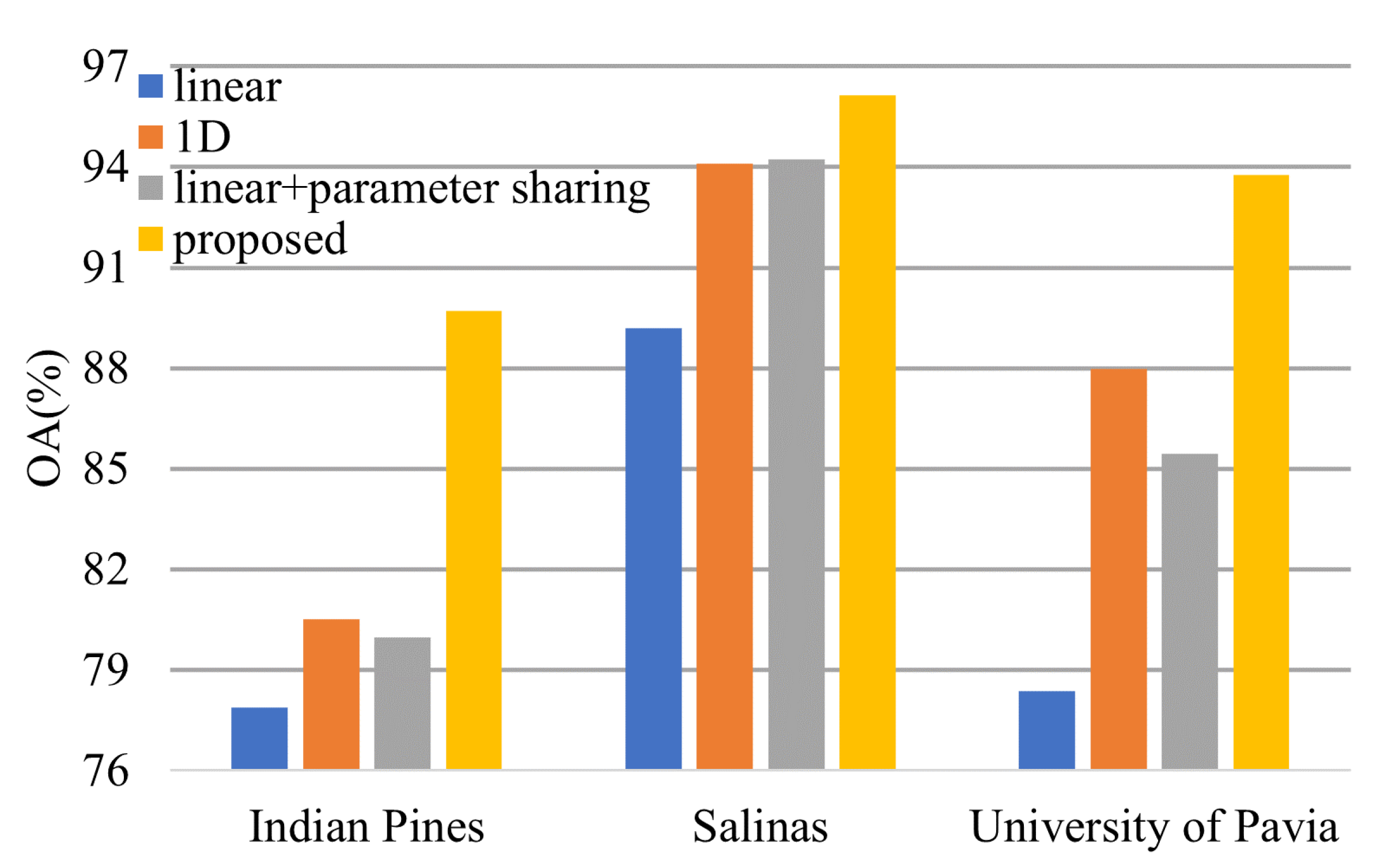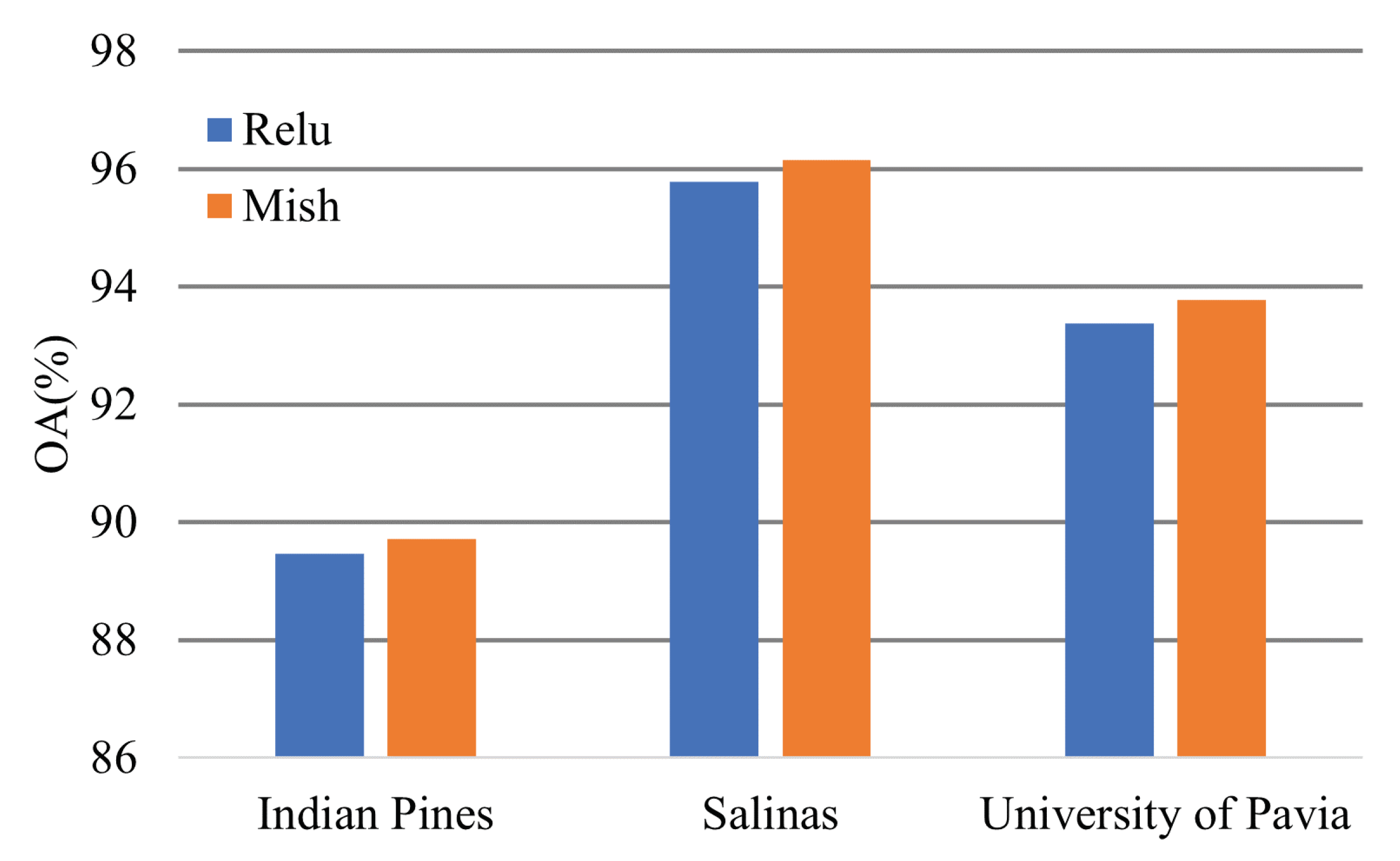Figure 1.
The overall architecture of our proposed model.
Figure 1.
The overall architecture of our proposed model.
Figure 2.
The computational process of 1-D convolution.
Figure 2.
The computational process of 1-D convolution.
Figure 3.
The architecture of the transformer encoder.
Figure 3.
The architecture of the transformer encoder.
Figure 4.
The difference between Mish and Relu.
Figure 4.
The difference between Mish and Relu.
Figure 5.
(a) False-color Indian Pines image. (b) Ground-truth map of the Indian Pines data set.
Figure 5.
(a) False-color Indian Pines image. (b) Ground-truth map of the Indian Pines data set.
Figure 6.
(a) False-color Salinas image. (b) Ground-truth map of the Salinas data set.
Figure 6.
(a) False-color Salinas image. (b) Ground-truth map of the Salinas data set.
Figure 7.
(a) False-color University of Pavia image. (b) Ground-truth map of the University of Pavia data set.
Figure 7.
(a) False-color University of Pavia image. (b) Ground-truth map of the University of Pavia data set.
Figure 8.
The overall spectral radiance and the corresponding categories in different data sets. (a) Indian Pines. (b) Salinas. (c) University of Pavia.
Figure 8.
The overall spectral radiance and the corresponding categories in different data sets. (a) Indian Pines. (b) Salinas. (c) University of Pavia.
Figure 9.
The spectral radiance of different pixels and the corresponding categories in Indian Pines. (a) Alfalfa. (b) Corn-notill. (c) Corn-mintill. (d) Corn. (e) Grass-pasture. (f) Grass-trees. (g) Grass-pasture-mowed. (h) Hay-windrowed. (i) Oats. (j) Soybean-notill. (k) Soybean-mintill. (l) Soybean-clean. (m) Wheat. (n) Woods. (o) Buildings-Grass-Trees-Drives. (p) Stone-Steel-Towers.
Figure 9.
The spectral radiance of different pixels and the corresponding categories in Indian Pines. (a) Alfalfa. (b) Corn-notill. (c) Corn-mintill. (d) Corn. (e) Grass-pasture. (f) Grass-trees. (g) Grass-pasture-mowed. (h) Hay-windrowed. (i) Oats. (j) Soybean-notill. (k) Soybean-mintill. (l) Soybean-clean. (m) Wheat. (n) Woods. (o) Buildings-Grass-Trees-Drives. (p) Stone-Steel-Towers.
Figure 10.
The spectral radiance of different pixels and the corresponding categories in Salinas. (a) Brocoli_green_weeds_1. (b) Brocoli_green_weeds_2. (c) Fallow. (d) Fallow_rough_plow. (e) Fallow_smooth. (f) Stubble. (g) Celery. (h) Grapes_untrained. (i) Soil_vinyard_develop. (j) Corn_senesced_green_weeds. (k) Lettuce_romaine_4wk. (l) Lettuce_romaine_5wk. (m) Lettuce_romaine_6wk. (n) Lettuce_romaine_7wk. (o) Vinyard_untrained. (p) Vinyard_vertical_trellis.
Figure 10.
The spectral radiance of different pixels and the corresponding categories in Salinas. (a) Brocoli_green_weeds_1. (b) Brocoli_green_weeds_2. (c) Fallow. (d) Fallow_rough_plow. (e) Fallow_smooth. (f) Stubble. (g) Celery. (h) Grapes_untrained. (i) Soil_vinyard_develop. (j) Corn_senesced_green_weeds. (k) Lettuce_romaine_4wk. (l) Lettuce_romaine_5wk. (m) Lettuce_romaine_6wk. (n) Lettuce_romaine_7wk. (o) Vinyard_untrained. (p) Vinyard_vertical_trellis.
Figure 11.
The spectral radiance of different pixels and the corresponding categories in the University of Pavia. (a) Asphalt. (b) Meadows. (c) Gravel. (d) Trees. (e) Painted metal sheets. (f) Bare Soil. (g) Bitumen. (h) Self-Blocking Bricks. (i) Shadows.
Figure 11.
The spectral radiance of different pixels and the corresponding categories in the University of Pavia. (a) Asphalt. (b) Meadows. (c) Gravel. (d) Trees. (e) Painted metal sheets. (f) Bare Soil. (g) Bitumen. (h) Self-Blocking Bricks. (i) Shadows.
Figure 12.
The classification maps of Indian Pines. (a) Ground-truth map. (b)–(f) Classification results of 2-D-convolutional neural network (CNN), 3-D-CNN, Multi-3-D-CNN, HybridSN, and Transformer.
Figure 12.
The classification maps of Indian Pines. (a) Ground-truth map. (b)–(f) Classification results of 2-D-convolutional neural network (CNN), 3-D-CNN, Multi-3-D-CNN, HybridSN, and Transformer.
Figure 13.
The classification maps of Salinas. (a) Ground-truth map. (b)–(f) Classification results of 2-D-CNN, 3-D-CNN, Multi-3-D-CNN, HybridSN, and Transformer.
Figure 13.
The classification maps of Salinas. (a) Ground-truth map. (b)–(f) Classification results of 2-D-CNN, 3-D-CNN, Multi-3-D-CNN, HybridSN, and Transformer.
Figure 14.
The classification maps of the University of Pavia. (a) Ground-truth map. (b)–(f) Classification results of 2-D-CNN, 3-D-CNN, Multi-3-D-CNN, HybridSN, and Transformer.
Figure 14.
The classification maps of the University of Pavia. (a) Ground-truth map. (b)–(f) Classification results of 2-D-CNN, 3-D-CNN, Multi-3-D-CNN, HybridSN, and Transformer.
Figure 15.
The classification maps of Indian Pines. (a) Ground-truth map. (b) Classification results of the Transformer without metric learning. (c) Classification results of the Transformer with metric learning.
Figure 15.
The classification maps of Indian Pines. (a) Ground-truth map. (b) Classification results of the Transformer without metric learning. (c) Classification results of the Transformer with metric learning.
Figure 16.
The classification maps of Salinas. (a) Ground-truth map. (b) Classification results of the Transformer without metric learning. (c) Classification results of the Transformer with metric learning.
Figure 16.
The classification maps of Salinas. (a) Ground-truth map. (b) Classification results of the Transformer without metric learning. (c) Classification results of the Transformer with metric learning.
Figure 17.
The classification maps of University of Pavia. (a) Ground-truth map. (b) Classification results of the Transformer without metric learning. (c) Classification results of the Transformer with metric learning.
Figure 17.
The classification maps of University of Pavia. (a) Ground-truth map. (b) Classification results of the Transformer without metric learning. (c) Classification results of the Transformer with metric learning.
Figure 18.
Effectiveness of the 1-D convolution and parameter sharing.
Figure 18.
Effectiveness of the 1-D convolution and parameter sharing.
Figure 19.
Effectiveness of the activation function.
Figure 19.
Effectiveness of the activation function.
Table 1.
Training, validation, and testing sample numbers in Indian Pines.
Table 1.
Training, validation, and testing sample numbers in Indian Pines.
| Number | Name | Training | Validation | Testing | Total |
|---|
| 1 | Alfalfa | 1 | 1 | 44 | 46 |
| 2 | Corn-notill | 42 | 42 | 1344 | 1428 |
| 3 | Corn-mintill | 24 | 24 | 782 | 830 |
| 4 | Corn | 7 | 7 | 223 | 237 |
| 5 | Grass-pasture | 14 | 14 | 455 | 483 |
| 6 | Grass-trees | 21 | 21 | 688 | 730 |
| 7 | Grass-pasture-mowed | 1 | 1 | 26 | 28 |
| 8 | Hay-windrowed | 14 | 14 | 450 | 478 |
| 9 | Oats | 1 | 1 | 18 | 20 |
| 10 | Soybean-notill | 29 | 29 | 914 | 972 |
| 11 | Soybean-mintill | 73 | 72 | 2310 | 2455 |
| 12 | Soybean-clean | 17 | 17 | 559 | 593 |
| 13 | Wheat | 6 | 6 | 193 | 205 |
| 14 | Woods | 37 | 37 | 1191 | 1265 |
| 15 | Buildings-Grass-Trees-Drives | 11 | 11 | 364 | 386 |
| 16 | Stone-Steel-Towers | 2 | 3 | 88 | 93 |
| | Total | 300 | 300 | 9649 | 10,249 |
Table 2.
Training, validation, and testing sample numbers in Salinas.
Table 2.
Training, validation, and testing sample numbers in Salinas.
| Number | Name | Training | Validation | Testing | Total |
|---|
| 1 | Brocoli-green-weeds-1 | 8 | 8 | 1993 | 2009 |
| 2 | Brocoli-green-weeds-2 | 14 | 14 | 3698 | 3726 |
| 3 | Fallow | 7 | 8 | 1961 | 1976 |
| 4 | Fallow-rough-plow | 5 | 5 | 1384 | 1394 |
| 5 | Fallow-smooth | 10 | 10 | 2658 | 2678 |
| 6 | Stubble | 15 | 15 | 3929 | 3959 |
| 7 | Celery | 14 | 14 | 3551 | 3579 |
| 8 | Grapes-untrained | 45 | 44 | 11,182 | 11,271 |
| 9 | Soil-vinyard-develop | 24 | 24 | 6155 | 6203 |
| 10 | Corn-senesced-green-weeds | 13 | 13 | 3252 | 3278 |
| 11 | Lettuce-romaine-4wk | 4 | 4 | 1060 | 1068 |
| 12 | Lettuce-romaine-5wk | 7 | 7 | 1913 | 1927 |
| 13 | Lettuce-romaine-6wk | 3 | 4 | 909 | 916 |
| 14 | Lettuce-romaine-7wk | 4 | 4 | 1062 | 1070 |
| 15 | Vinyard-untrained | 29 | 28 | 7211 | 7268 |
| 16 | Vinyard-vertical-trellis | 7 | 7 | 1793 | 1807 |
| | Total | 209 | 209 | 53,711 | 54,129 |
Table 3.
Training, validation, and testing sample numbers in the University of Pavia.
Table 3.
Training, validation, and testing sample numbers in the University of Pavia.
| Number | Name | Training | Validation | Testing | Total |
|---|
| 1 | Asphalt | 33 | 33 | 6565 | 6631 |
| 2 | Meadows | 93 | 91 | 18,465 | 18,649 |
| 3 | Gravel | 10 | 10 | 2079 | 2099 |
| 4 | Trees | 15 | 15 | 3034 | 3064 |
| 5 | Painted metal sheets | 6 | 7 | 1332 | 1345 |
| 6 | Bare Soil | 25 | 25 | 4979 | 5029 |
| 7 | Bitumen | 6 | 6 | 1318 | 1330 |
| 8 | Self-Blocking Bricks | 18 | 18 | 3646 | 3682 |
| 9 | Shadows | 4 | 5 | 938 | 947 |
| | Total | 210 | 210 | 42,356 | 42,776 |
Table 4.
Configuration of our proposed model variants.
Table 4.
Configuration of our proposed model variants.
| Data set | Layers | Hidden Size | MLP size | Heads |
|---|
| Indian Pines | 2 | 120 | 32 | 15 |
| Salinas | 2 | 75 | 32 | 15 |
| University of Pavia | 2 | 75 | 32 | 15 |
Table 5.
Parameter summary of the proposed transformer model architecture over the Indian Pines data set.
Table 5.
Parameter summary of the proposed transformer model architecture over the Indian Pines data set.
| Layer (Type) | Output Shape | Parameter |
|---|
| inputLayer | (30, 25, 25) | 0 |
| conv1d | (1, 120) × 25 | 632 × 25 |
| 2-layer transformer encoder | (1, 120) | 132,064 |
| layernorm | (120) | 240 |
| linear | (32) | 3872 |
| Mish | (32) | 0 |
| linear | (16) | 528 |
| Total Trainable Parameters: 152,504 |
Table 6.
Parameter summary of the proposed transformer model architecture over the Salinas data set.
Table 6.
Parameter summary of the proposed transformer model architecture over the Salinas data set.
| Layer (Type) | Output Shape | Parameter |
|---|
| inputLayer | (15, 25, 25) | 0 |
| conv1d | (1, 75) × 25 | 302 × 25 |
| 2-layer transformer encoder | (1, 75) | 55,564 |
| layernorm | (75) | 150 |
| linear | (32) | 2432 |
| Mish | (32) | 0 |
| linear | (16) | 528 |
| Total Trainable Parameters: 66,224 |
Table 7.
Parameter summary of the proposed transformer model architecture over the University of Pavia data set.
Table 7.
Parameter summary of the proposed transformer model architecture over the University of Pavia data set.
| Layer (Type) | Output Shape | Parameter |
|---|
| inputLayer | (15, 25, 25) | 0 |
| conv1d | (1, 75) × 25 | 302 × 25 |
| 2-layer transformer encoder | (1, 75) | 55,564 |
| layernorm | (75) | 150 |
| linear | (32) | 2432 |
| Mish | (32) | 0 |
| linear | (9) | 297 |
| Total Trainable Parameters: 65,993 |
Table 8.
Classification results of different models in Indian Pines.
Table 8.
Classification results of different models in Indian Pines.
| No. | Training Samples | 2-D-CNN | 3-D-CNN | multi-3-D-CNN | HybridSN | Transformer |
|---|
| 1 | 1 | 95.21 | 91.16 | 100.00 | 93.20 | 90.92 |
| 2 | 42 | 66.10 | 69.60 | 61.43 | 83.53 | 86.70 |
| 3 | 24 | 86.24 | 83.31 | 81.52 | 85.33 | 85.09 |
| 4 | 7 | 90.38 | 93.39 | 99.40 | 83.77 | 88.03 |
| 5 | 14 | 96.09 | 91.34 | 96.82 | 87.87 | 94.55 |
| 6 | 21 | 94.44 | 95.77 | 97.46 | 93.12 | 95.67 |
| 7 | 1 | 100.00 | 100.00 | 99.41 | 86.43 | 91.76 |
| 8 | 14 | 99.29 | 98.42 | 99.43 | 92.48 | 96.42 |
| 9 | 1 | 98.75 | 95.66 | 99.23 | 85.84 | 88.33 |
| 10 | 29 | 93.18 | 86.59 | 84.59 | 85.34 | 91.12 |
| 11 | 73 | 83.94 | 84.19 | 74.61 | 89.53 | 88.85 |
| 12 | 17 | 83.52 | 77.94 | 79.98 | 79.45 | 81.18 |
| 13 | 6 | 98.55 | 98.35 | 99.81 | 92.59 | 96.23 |
| 14 | 37 | 94.89 | 92.65 | 88.89 | 94.18 | 94.55 |
| 15 | 11 | 87.33 | 88.18 | 86.17 | 85.99 | 86.54 |
| 16 | 2 | 98.91 | 95.75 | 90.00 | 84.16 | 79.63 |
| KAPPA | | | | | |
| OA(%) | | | | | |
| AA(%) | | | | | |
Table 9.
Classification results of different models in Salinas.
Table 9.
Classification results of different models in Salinas.
| No. | Training Samples | 2-D-CNN | 3-D-CNN | multi-3-D-CNN | HybridSN | Transformer |
|---|
| 1 | 8 | 97.73 | 99.85 | 98.17 | 96.95 | 98.47 |
| 2 | 14 | 99.55 | 98.99 | 98.90 | 97.24 | 98.54 |
| 3 | 7 | 95.64 | 94.40 | 93.01 | 98.82 | 98.02 |
| 4 | 5 | 95.82 | 95.96 | 90.97 | 96.57 | 95.59 |
| 5 | 10 | 95.36 | 96.48 | 95.46 | 96.25 | 96.04 |
| 6 | 15 | 99.69 | 99.06 | 98.32 | 97.24 | 97.98 |
| 7 | 14 | 99.43 | 98.09 | 99.12 | 99.21 | 99.03 |
| 8 | 45 | 88.46 | 87.04 | 90.37 | 95.05 | 94.27 |
| 9 | 24 | 99.71 | 99.29 | 99.00 | 98.78 | 98.97 |
| 10 | 13 | 98.93 | 96.13 | 95.44 | 95.69 | 95.90 |
| 11 | 4 | 98.52 | 88.73 | 94.46 | 97.62 | 98.30 |
| 12 | 7 | 93.75 | 92.55 | 93.44 | 97.96 | 94.58 |
| 13 | 3 | 91.00 | 86.05 | 87.08 | 90.45 | 89.99 |
| 14 | 4 | 93.01 | 93.60 | 90.15 | 94.14 | 98.20 |
| 15 | 29 | 85.40 | 86.27 | 84.28 | 87.09 | 92.75 |
| 16 | 7 | 99.49 | 96.38 | 94.34 | 96.27 | 99.89 |
| KAPPA | | | | | |
| OA(%) | | | | | |
| AA(%) | | | | | |
Table 10.
Classification results of different models in the University of Pavia.
Table 10.
Classification results of different models in the University of Pavia.
| No. | Training Samples | 2-D-CNN | 3-D-CNN | multi-3-D-CNN | HybridSN | Transformer |
|---|
| 1 | 33 | 72.50 | 70.35 | 71.81 | 83.17 | 89.98 |
| 2 | 93 | 94.77 | 95.83 | 96.62 | 96.64 | 96.89 |
| 3 | 10 | 85.90 | 62.36 | 73.75 | 70.79 | 88.56 |
| 4 | 15 | 95.62 | 77.50 | 84.48 | 84.67 | 94.82 |
| 5 | 6 | 97.54 | 98.49 | 96.05 | 94.76 | 92.43 |
| 6 | 25 | 97.06 | 96.47 | 94.88 | 94.94 | 98.06 |
| 7 | 6 | 97.78 | 80.24 | 83.94 | 80.61 | 88.01 |
| 8 | 18 | 77.08 | 64.31 | 69.62 | 71.55 | 84.98 |
| 9 | 4 | 87.23 | 69.38 | 71.26 | 85.06 | 93.89 |
| KAPPA | | | | | |
| OA(%) | | | | | |
| AA(%) | | | | | |
Table 11.
Parameter size of the five methods on the three hyperspectral data sets.
Table 11.
Parameter size of the five methods on the three hyperspectral data sets.
| Network | Indian Pines | Salinas | PaviaU |
|---|
| 2-D-CNN | 176,736 | 165,936 | 98,169 |
| 0.67 MB | 0.63 MB | 0.72 MB |
| 3-D-CNN | 1,018,476 | 771,516 | 447,374 |
| 3.89 MB | 2.94 MB | 1.71 MB |
| multi-3-D-CNN | 634,592 | 138,976 | 84,761 |
| 2.42 MB | 0.53 MB | 0.32 MB |
| HybridSN | 5,122,176 | 4,845,696 | 4,844,793 |
| 19.54 MB | 18.48 MB | 18.48 MB |
| Transformer | 152,504 | 66,224 | 65,993 |
| 0.58 MB | 0.25 MB | 0.25 MB |
Table 12.
Flops of the five methods on the three hyperspectral data sets.
Table 12.
Flops of the five methods on the three hyperspectral data sets.
| Network | Indian Pines | Salinas | PaviaU |
|---|
| 2-D-CNN | 11,708,240 | 5,995,040 | 5,927,280 |
| 3-D-CNN | 162,511,650 | 83,938,540 | 83,614,405 |
| multi-3-D-CNN | 52,409,984 | 20,611,712 | 20,557,504 |
| HybridSN | 248,152,512 | 50,948,592 | 50,947,696 |
| Transformer | 5,294,912 | 1,988,762 | 1,988,538 |
Table 13.
Running time of the five methods on the Indian Pines data set.
Table 13.
Running time of the five methods on the Indian Pines data set.
| Data set | Algorithm | Training Time (s) | Testing Time (s) |
|---|
| Indian Pines | 2-D-CNN | 11.0 | 0.5 |
| 3-D-CNN | 54.1 | 4.26 |
| multi-3-D-CNN | 56.23 | 5.10 |
| HybridSN | 43.9 | 3.45 |
| Transformer | 32.24 | 1.31 |
Table 14.
Running time of the five methods on the Salinas data set.
Table 14.
Running time of the five methods on the Salinas data set.
| Data set | Algorithm | Training Time (s) | Testing Time (s) |
|---|
| Salinas | 2-D-CNN | 6.0 | 1.9 |
| 3-D-CNN | 26.1 | 16.1 |
| multi-3-D-CNN | 26.2 | 18.2 |
| HybridSN | 13.9 | 7.5 |
| Transformer | 13.8 | 4.6 |
Table 15.
Running time of the five methods on the University of Pavia data set.
Table 15.
Running time of the five methods on the University of Pavia data set.
| Data set | Algorithm | Training Time (s) | Testing Time (s) |
|---|
| University of Pavia | 2-D-CNN | 5.8 | 1.5 |
| 3-D-CNN | 26.2 | 12.7 |
| multi-3-D-CNN | 26.2 | 14.2 |
| HybridSN | 14.06 | 5.78 |
| Transformer | 13.09 | 3.33 |
Table 16.
Classification results of the transformer without metric learning and the transformer with metric learning.
Table 16.
Classification results of the transformer without metric learning and the transformer with metric learning.
| | Indian Pines | Salinas |
|---|
| No. | without | with | without | with |
|---|
| | Metric Learning | Metric Learning | Metric Learning | Metric Learning |
|---|
| 1 | 99.16 | 90.92 | 98.47 | 98.47 |
| 2 | 85.41 | 86.70 | 98.69 | 98.54 |
| 3 | 84.68 | 85.09 | 96.58 | 98.02 |
| 4 | 85.99 | 88.03 | 93.18 | 95.59 |
| 5 | 92.39 | 94.55 | 96.34 | 96.04 |
| 6 | 94.99 | 95.67 | 98.25 | 97.98 |
| 7 | 72.42 | 91.76 | 99.10 | 99.03 |
| 8 | 95.71 | 96.42 | 93.83 | 94.27 |
| 9 | 79.72 | 88.33 | 99.39 | 98.97 |
| 10 | 89.07 | 91.12 | 96.13 | 95.90 |
| 11 | 89.17 | 88.85 | 98.46 | 98.30 |
| 12 | 79.96 | 81.18 | 94.71 | 94.58 |
| 13 | 96.65 | 96.23 | 91.32 | 89.99 |
| 14 | 95.47 | 94.55 | 97.16 | 98.21 |
| 15 | 89.88 | 86.54 | 92.36 | 92.75 |
| 16 | 89.52 | 79.63 | 99.93 | 99.89 |
| KAPPA | | | | |
| OA(%) | | | | |
| AA(%) | | | | |
| University of Pavia |
| No. | without Metric Learning | with Metric Learning |
| 1 | 87.92 | 89.98 |
| 2 | 96.80 | 96.89 |
| 3 | 88.09 | 88.56 |
| 4 | 92.32 | 94.82 |
| 5 | 89.57 | 92.43 |
| 6 | 96.60 | 98.06 |
| 7 | 91.47 | 88.01 |
| 8 | 85.53 | 84.98 |
| 9 | 83.79 | 93.89 |
| KAPPA | | |
| OA(%) | | |
| AA(%) | | |
